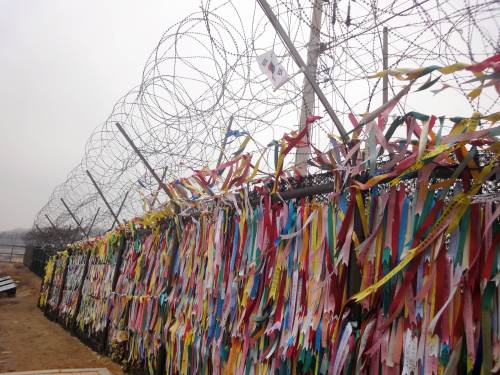Gun-toting soldiers patrol guard posts overlooking North Korean territory beyond a barbed-wire fence. Hundreds of red flags with a skull motif dot roadsides, warning of mines.
This is the area which South Korea hopes to turn into a major eco-tourism attraction.
Untouched by developers for six decades due to the military standoff, the scenic areas surrounding the world’s last Cold War frontier have paradoxically become a peaceful haven for wildlife.
The 155-mile-long (248-kilometer) borderline which bisects the peninsula was fixed when the 1950-53 war ended with an armistice. A Demilitarized Zone (DMZ) extending for two kilometers each side of the line was designated as a buffer zone.
Thousands of tourists who visit the truce village of Panmunjom within the DMZ each year get a grim reminder of the peninsula’s tragic past.
Now Seoul is trying to put a more positive spin on the border region, by promoting its ecological value and opening trekking routes which will also give visitors a glimpse of the secretive North.
“The DMZ has been no man’s land for decades, making its well-preserved natural surroundings a perfect site for eco-tourism,” Park Mee-ja, a director of the environment ministry’s nature policy division, told AFP.
 |
This photo taken on March 14, 2012 shows messages of hope for reunification on a military barbed wire fence at Imjingak Peace Park in Paju near the Demilitarized Zone (DMZ) dividing the two Koreas. (AFP-Yonhap News) |
“There is so much more to this area than just the sad history and the war.”
The DMZ and surrounding area are home to nearly 3,000 plants and animals ― including otters, mountain sheep, musk deer and dozens of other species ― nearly extinct elsewhere in the crowded South, according to the government.
Civilians are barred from entering the DMZ except at Panmunjom. The South’s military also restricts civilian access to the strip of land immediately south of the zone.
The DMZ itself will remain off-limits to visitors.
But after long deliberation the South’s army is finally set to sign an agreement this month to open up its outskirts ― and to help develop routes free of mines.
Nature trails seven to nine kilometers long, each of which generally takes six to eight hours to walk, are set to open next year in the east of the country.
“You will be able to walk right alongside the barbed wire of the DMZ, look over North Korean territory from hills, or see battlefield relics that have been left untouched for decades,” said Park.
Several areas already offer small-scale nature-watching programs near the DMZ.
But the trails to open next year will be the longest through the area south of the DMZ, said Park.
The routes were initially developed by the army years ago to patrol the areas and troops will accompany trekking teams to prevent hikers from deviating from the mine-free paths.
Seoul is also asking the United Nations cultural organization UNESCO to designate the DMZ as one of some 500 global Biosphere Reserves.
Efforts began in 2005 to open up the southern approaches to the DMZ. But Park said periodic cross-border tensions delayed the plan, with the military squeamish about letting civilians into sensitive areas. (AFP)





![[Exclusive] Hyundai Mobis eyes closer ties with BYD](http://res.heraldm.com/phpwas/restmb_idxmake.php?idx=644&simg=/content/image/2024/11/25/20241125050044_0.jpg)
![[Herald Review] 'Gangnam B-Side' combines social realism with masterful suspense, performance](http://res.heraldm.com/phpwas/restmb_idxmake.php?idx=644&simg=/content/image/2024/11/25/20241125050072_0.jpg)

